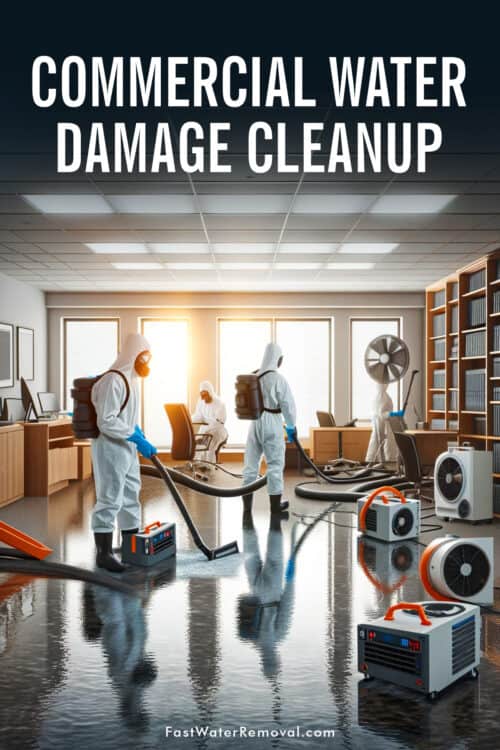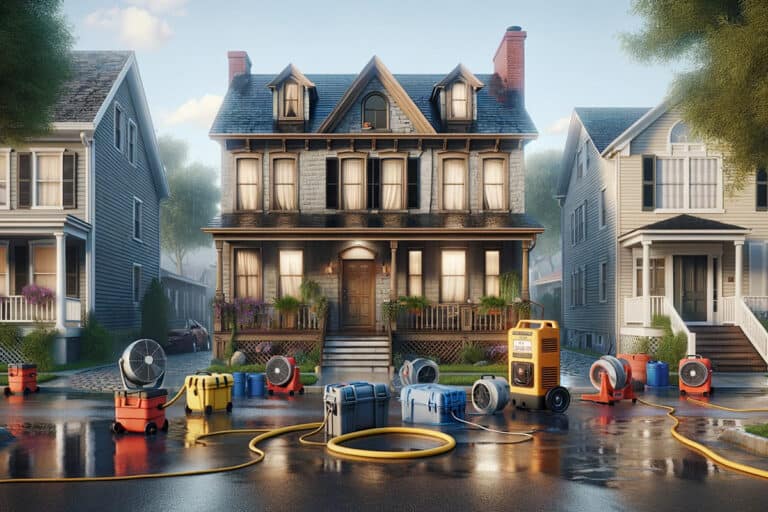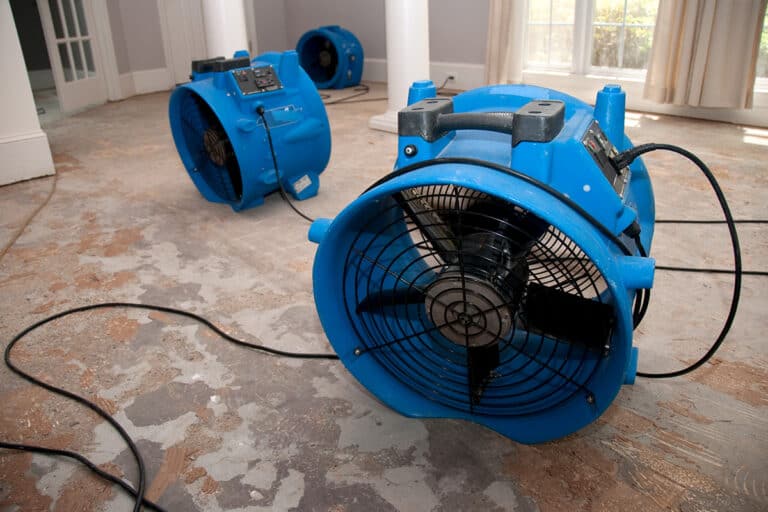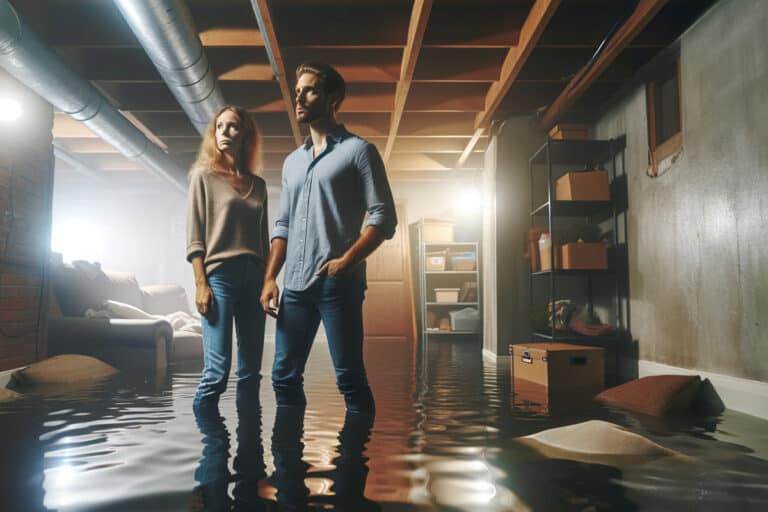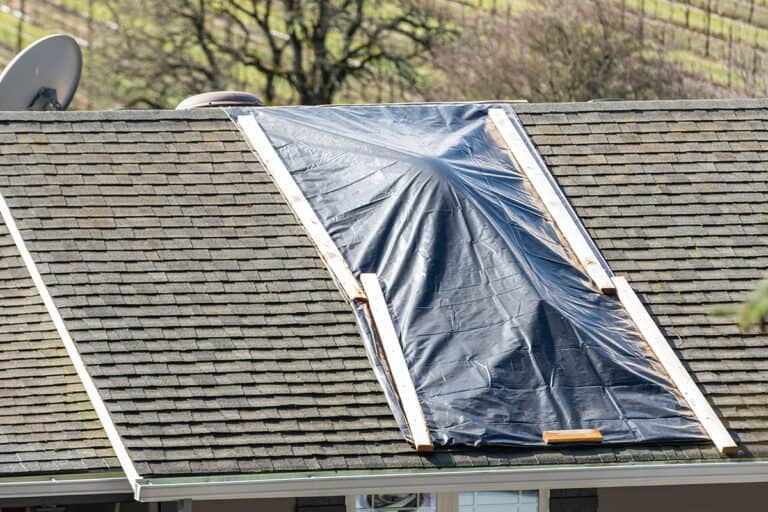Disclosure: I am compensated for purchases made through some links on this site. Click for details.
Water damage in a commercial setting can have far-reaching consequences, impacting not only the premises but also the overall operation of the business. When such an event occurs, it is crucial to engage in comprehensive water damage cleanup to restore the affected area to prevent further damage and loss. Restoration professionals are equipped to handle the complexities of water damage in commercial environments, ensuring a thorough process from assessment to repair.
The process of commercial water damage cleanup involves emergency response and assessment, followed by water extraction and drying. Restoration experts utilize state-of-the-art equipment and advanced techniques to manage the damage efficiently. In the face of such disruptions, businesses must also consider the financial implications of water damage, including insurance claims and preventive strategies for future incidents.
Choosing the right water damage restoration company is critical for effective cleanup and recovery. These companies can manage the entire scope of damage, from removing water and mitigating any immediate threats to sanitizing the area and conducting necessary repairs. A trusted restoration partner ensures the continuity of commercial operations with minimal downtime.
Key Takeaways
- Timely restoration services are essential for minimizing commercial water damage impact.
- A systematic approach is taken to water damage cleanup, from removal to reconstruction.
- Selecting a reputable restoration company is crucial for efficient and effective cleanup.
Understanding Commercial Water Damage
Commercial water damage is a critical concern that can lead to substantial financial loss and operational downtime. Property managers and business owners need to recognize the various types of water damage, understand their common causes, and identify the signs early to mitigate the impact effectively.
Types of Water Damage
Commercial water damage typically falls into three categories, each varying in severity and source. Clean water damage originates from sanitary sources like leaking pipes or overflow from sinks. Gray water damage, more serious than clean water, involves slightly contaminated water which can come from dishwasher or washing machine leaks. Lastly, black water damage is the most hazardous, often stemming from sewage problems or floodwaters and posing significant health risks.
Common Causes of Water Damage
Various factors can cause water damage within commercial settings. Leaking pipes and roof leaks are frequent culprits, often due to wear and tear or inadequate maintenance. Extreme weather events and natural disasters, like hurricanes or flash floods, can lead to flood damage that quickly overwhelms a property. Business owners must recognize that these sources not only affect the structure but also can interrupt business operations.
Identifying Signs of Water Damage
Early detection is vital. Signs of water damage can include visible water spots on ceilings or walls, which often indicate a leak. Persistent musty odors can suggest the presence of hidden dampness, and issues such as warping or bubbling of floors and walls may signal extensive water intrusion. Monitoring for such indicators can prevent minor issues from escalating into costly repairs.
Emergency Response and Initial Assessment
In the event of water damage, the speed and effectiveness of the initial response are crucial. This section outlines the crucial steps that companies must undertake, from crafting a tailored emergency plan to conducting a thorough inspection post-water damage.
Developing an Emergency Plan
An effective emergency plan is the cornerstone of any commercial property’s response to water-related disasters. This plan should include clear emergency contact information, define roles and responsibilities within the emergency service team, and outline the procedures for dealing with various scenarios, including floods and storms. The plan must address both the prevention of water damage and the necessary steps for a fast response when an incident occurs.
Immediate Steps After Water Damage
Once water damage is discovered, immediate steps involve stopping the source of water and mitigating damage. This begins with identifying and shutting off the main water valve and, when necessary, contacting professional restoration services that offer a fast response. Time is of the essence to prevent further damage, making it imperative to initiate water extraction and area containment quickly.
Commercial Water Damage Inspection
A thorough inspection conducted by professionals will help assess the extent of the damage. This includes identifying the categories and classes of water damage to ensure an accurate and effective restoration process. Inspection must be systematic and start as soon as the area is safe to enter to ensure that a proper action plan can be developed rapidly.
Water Removal and Mitigation Process
Effective water damage restoration involves immediate water removal and mitigation to prevent further damage and costs. A swift response can minimize the disruption to commercial operations, ensuring a more expedient return to normalcy.
Water Extraction Techniques
Water extraction is the first critical step in water damage restoration. High-powered pumps and vacuums are utilized to remove water from the affected areas promptly. These machines are capable of extracting large volumes of water from carpets, upholstery, and substrates, significantly reducing drying time and preventing the spread of moisture to unaffected areas.
Preventing Secondary Damage
After the initial water removal, the focus shifts to preventing secondary damage such as warping, swelling of structural components, and material breakdown. Commercial dehumidifiers and air movers are strategically placed to remove lingering moisture from the air and surfaces. Ongoing moisture monitoring is essential to ensure that the environment is kept at optimal levels for drying.
Mold and Contaminant Control
Water damage can create ideal conditions for mold growth and the spread of contaminants. Prompt water mitigation includes identifying and isolating areas of concern and starting the sanitizing process. Proper cleaning, application of antimicrobial treatments, and air filtration are vital in maintaining healthy indoor air quality and preventing mold from taking hold.
Drying and Dehumidification
Effectively managing the moisture in a commercial space after water damage is critical. The drying and dehumidification process involves using professional equipment to ensure the environment is properly dried, thus preventing further damage or mold growth.
Use of Industrial Dehumidifiers
Industrial dehumidifiers play a pivotal role in extracting water vapor from the air. They are designed to operate at a larger scale, suitable for commercial properties that have suffered water damage. These devices maintain appropriate humidity levels, crucial for structural drying and reducing the drying time.
Air Circulation and Drying Strategies
Strategic placement of air movers significantly enhances the drying process. They facilitate consistent air circulation across walls, carpets, and furniture, which effectively evaporates moisture. Monitoring the drying process is imperative, ensuring that the dehumidifiers and air movers are repositioned regularly for optimal performance and thorough drying of the affected area.
Cleaning and Sanitizing
Effective cleaning and sanitizing are fundamental to restoring a commercial property after water damage. They involve a detailed process aimed at removing contaminants and reducing the potential for health issues. Professionals must adhere to strict protocols to ensure that all surfaces are thoroughly cleaned and sanitized.
Contents Restoration
When undertaking restoration of contents, professionals assess all affected items to determine the best cleaning method. Clean water, typically from freshwater sources, generally requires simpler restoration techniques, while gray and black water—from sources like sinks, toilets, or sewage backups—necessitate more rigorous and specialized approaches. The goal is to restore items to their pre-damage condition, ensuring they are safe and free of contaminants.
Health and Safety Considerations
Addressing health and safety considerations is paramount during the cleaning and sanitizing phase of water damage restoration. Technicians must use personal protective equipment (PPE) and follow Occupational Safety and Health Administration (OSHA) guidelines during sewage cleanup to mitigate the risk of encountering hazardous substances. Proper sanitization protocols are employed to prevent the spread of microorganisms and protect the health of occupants post-restoration.
Commercial Restoration and Repair Services
When a commercial property suffers water damage, timely restoration and repair are of utmost importance. These services mitigate the impact on a business’s operations and help to prevent long-term structural issues and financial losses.
Restoration of Building Structure
The priority in commercial water damage restoration is to address any structural damage to the building. Certified technicians evaluate the integrity of the structural components, including floors, walls, and ceilings. Using state-of-the-art equipment, they ensure that moisture levels are reduced to safe levels before beginning any necessary reconstruction efforts.
Commercial Equipment and Machinery Repair
Water damage can severely affect commercial equipment and machinery, critical to business operations. To minimize downtime, restoration teams delicately handle the repair and cleaning of all affected items. Professionals employ advanced methods to restore equipment and machinery to their pre-damage conditions, ensuring they meet industry standards for safety and efficiency.
Final Restoration Steps
Upon completion of repairs, the final restoration steps involve a detailed inspection to confirm that all areas are restored to their original, or better, condition. This often includes refinishing, painting, and replacing materials as needed. To conclude commercial restoration, technicians ensure every aspect of the property is fully restored, down to the details that matter for a seamless return to business continuity.
Insurance and Financial Considerations
Commercial water damage can have significant financial implications and navigating the complexities of insurance claims is crucial for property owners. They must be knowledgeable about the terms of their insurance policies and proactive in their financial planning to ensure coverage of damages.
Navigating Insurance Claims
When faced with commercial water damage, timely contact with one’s insurance company is essential. Policyholders should immediately notify their insurers to start the claims process. They must carefully read through their policy to understand the scope of coverage for water damage, which may vary significantly from policy to policy. Insurance claims for water damage typically involve an adjuster assessing the extent of the property damage and determining the claim payout. Property owners should be prepared to negotiate with the insurance adjuster, ensuring that all damage is accurately reflected and remunerated.
Documentation and Loss Assessment
Thorough documentation is the backbone of substantiating an insurance claim. Property owners should maintain a detailed record of all damages, including photographs, videos, and a written inventory. Professionals may be consulted to provide a more formal assessment of the damage and the estimated repair costs. A comprehensive loss assessment aids in clearly communicating the extent of the damage to insurers, which is crucial for a successful claim. It is in the property owner’s best interest to be as detailed and accurate as possible to maximize their financial recovery from the insurance claim.
Preventive Measures and Maintenance
Effective commercial water damage cleanup begins well before any incident occurs. It hinges on a strategic plan that includes rigorous risk assessment and routine maintenance. By prioritizing prevention, businesses can minimize the likelihood and impact of water damage.
Risk Assessment and Prevention Planning
Identifying potential water damage risks is the first crucial step in safeguarding a commercial property. A comprehensive prevention plan should assess all possible sources of water damage, from natural events like floods to internal issues such as appliance ruptures. For effective flood prevention, businesses must evaluate local weather patterns and historical data, ensuring that measures like sandbags or flood barriers are readily available and that drainage systems are adequate and well-maintained.
Regular Maintenance and Inspections
Maintenance and inspections are critical for early detection and prevention of water damage. Scheduled checks of plumbing systems, appliances, and HVAC units help identify any wear and tear or potential breaches that could lead to water intrusion. Business owners should ensure that their maintenance teams regularly inspect roofing, windows, and doors for leaks and that all water-using appliances are functioning correctly to prevent appliance ruptures that could cause significant damage.
Choosing a Water Damage Restoration Company
When faced with commercial water damage, selecting the right restoration company is crucial to mitigate losses and ensure a thorough clean-up. It’s important to assess specific criteria and verify the company’s certifications to make an informed decision.
Criteria for Selecting a Professional Service
A reputable water damage restoration company should have a proven track record in the industry, with trained technicians who are licensed and insured. Businesses should look for companies that specialize in handling commercial damage and offer a swift response time to limit property damage. Additionally, the availability of state-of-the-art equipment and 24/7 emergency services are important factors for businesses to consider.
Certifications and Standards
Certifications are a testament to a company’s commitment to quality and best practices in water damage restoration. The industry recognizes the Institute of Inspection, Cleaning and Restoration Certification (IICRC) as a key standard; therefore, businesses should seek out IICRC certified professionals. Water damage specialists with such certifications adhere to the highest industry standards in restoration work and are knowledgeable about the different categories of water damage.
Conclusion
Addressing commercial water damage requires a holistic and proactive approach, blending immediate response with long-term preventive measures.
The impact of water damage on businesses can be profound, affecting not only the physical premises but also the financial and operational continuity.
By adhering to the essential steps outlined—from emergency response, water extraction, and drying, to cleaning, sanitizing, and restoration—businesses can navigate the aftermath of water damage more effectively.
Equally important is the selection of a reputable water damage restoration company, which ensures that the cleanup process is conducted efficiently, minimizing downtime and financial losses.
Furthermore, businesses must not overlook the importance of insurance and financial planning in mitigating the consequences of water damage. Being well-informed about insurance coverage, documenting damages meticulously, and engaging in negotiations can significantly aid in the recovery process.
Additionally, adopting preventive measures and routine maintenance practices can greatly reduce the risk of future water damage incidents, safeguarding the business’s assets, and ensuring its resilience against unforeseen challenges.
Ultimately, through comprehensive preparation, immediate action, and strategic planning, businesses can overcome the hurdles posed by commercial water damage, ensuring their swift return to normalcy and long-term sustainability.
